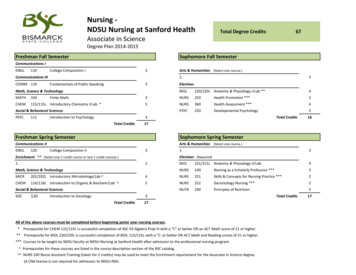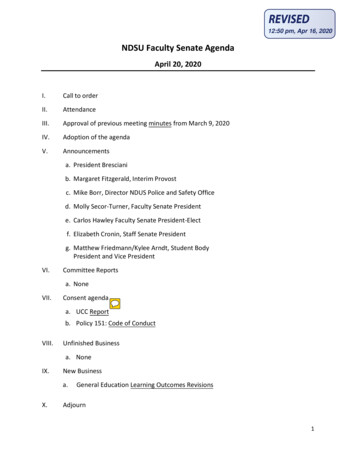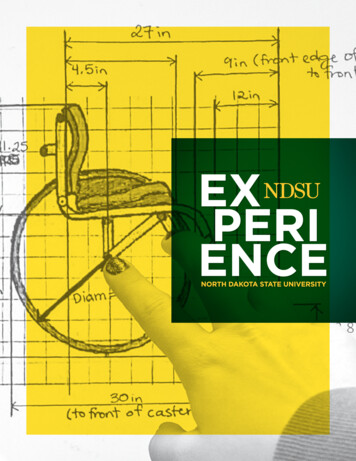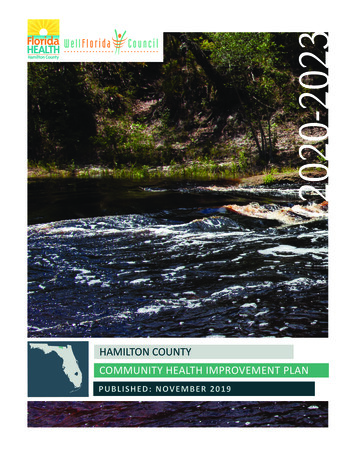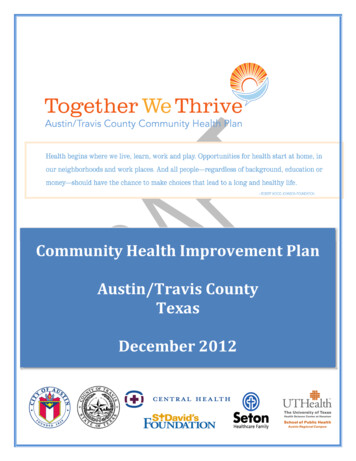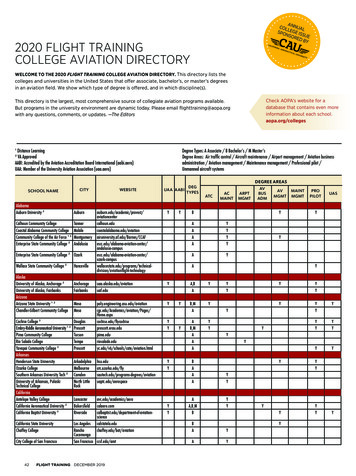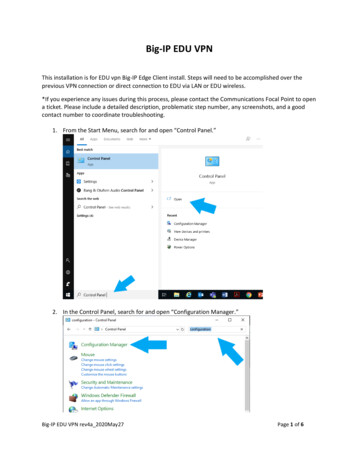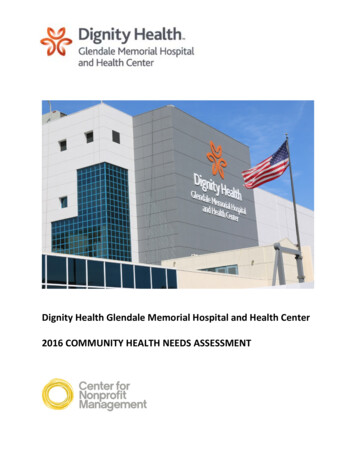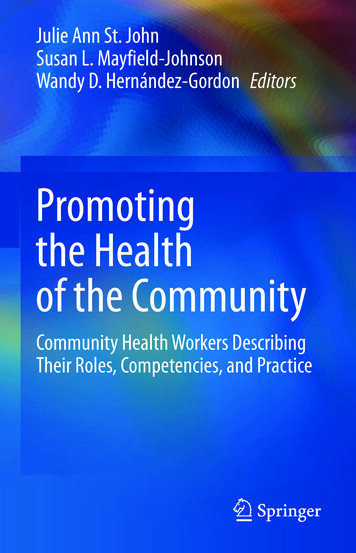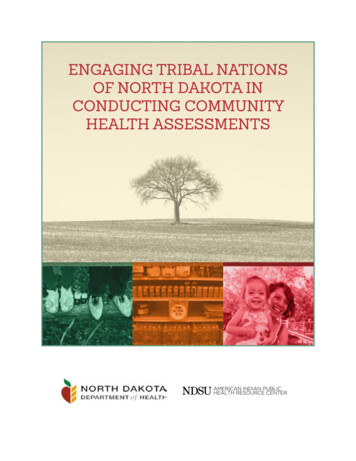
Transcription
ENGAGING TRIBAL NATIONSOF NORTH DAKOTA INCONDUCTING COMMUNITYHEALTH ASSESSMENTS
Hau. Pilamaye Yelo. Mitakuye Pi.Hello and Thank You to All My Relations,The Indian Self-Determination and Education Assistance Act (PL 93-638) gave tribalnations the authority to operate their own health care programs in 1975. The potentialfor development of locally delivered and managed clinical and public health servicesacross Indian Country has created hundreds of culturally appropriate clinical andpublic health programs and services. As important as providing these direct services,quality standards are essential as tribal health programs work to reduce health disparitiesand improve health outcomes in tribal communities.The Gaining Ground Initiative, managed by the National Network of Public HealthInstitutes, and supported by the Robert Wood Johnson Foundation, aims to promoteongoing quality improvement in public health departments, as they protect andimprove health in their communities. The American Indian Public Health ResourceCenter at North Dakota State University is proud to be part of the North Dakota’sGaining Ground Network.Through partnership with the North Dakota Department of Health – North DakotaGaining Ground Network, the American Indian Public Health Resource Centerdeveloped the Engaging Tribal Nations in North Dakota in Conducting CommunityHealth Assessments toolkit. This toolkit is designed as a step-by-step map for tribaland public health programs wishing to identify: Tribal community members’ healthpriorities; unmet health needs in tribal communities; and the effectiveness of existingtribal health services.On behalf of the NDSU American Indian Public Health Resource Center and Departmentof Public Health, I wish you success as you work to grow quality of health in IndianCountry.Anpetu wašte’ yuha’ po. Tanyaŋ omani po.Have a good day and a good journey,Donald K. Warne, MD, MPH (Oglala Lakota)Chair, Associate Professor and Mary J. Berg Distinguished Professorship in Women’s HealthDirector, American Indian Public Health Resource CenterNorth Dakota State University Department of Public HealthConducting Community Health Assessments1
ContributionsThank you to the following for their contributions in creating this toolkit:Donald Warne, MD, MPH (Oglala Lakota)Chair, NDSU Department of Public HealthMelanie Nadeau, MPH, PhD(c)(Turtle Mountain Band of Chippewa Indians)Operational Director, NDSU American Indian PublicHealth Resource CenterHannabah Blue, MSPH (Dine’)Public Health Services Project Manager, NDSUAmerican Indian Public Health Resource CenterGaining Ground Sub-Award Primary InvestigatorRuth Buffalo, MMgt, MBA, MPH(c)(MHA Nation)Public Health Services Graduate Assistant, NDSUAmerican Indian Public Health Resource CenterRamona Danielson, MS, PhDProgram Evaluator and Research Specialist, NDSUDepartment of Public HealthJacob Davis, MPH(Turtle Mountain Band of Chippewa Indians)MIECHV Research Assistant, NDSU Departmentof Public HealthGretchen Dobervich, BSW, LSWPublic Health Policy Project Manager, NDSU AmericanIndian Public Health Resource CenterPetra Reyna One Hawk, MPH(c)(Standing Rock Sioux)Public Health Education Graduate Assistant, NDSUAmerican Indian Public Health Resource CenterMelissa Reardon, BSMoney Follows the Person Tribal Initiative ProgramManager, NDSU Department of Public HealthJacob Walker-Swaney, MPH(c), PhD(c) (Potawatomi,Shawnee)Public Health Research Graduate Assistant, NDSUAmerican Indian Public Health Resource CenterPearl Walker-Swaney, MPH(Standing Rock Sioux, Leech Lake Objiwe)INBRE Project Manager, NDSU Departmentof Public HealthVanessa Tibbitts, MA (Oglala Lakota)Public Health Education Project Manager, NDSUAmerican Indian Public Health Resource CenterTansy Wells, MPH(c)Public Health Policy Graduate Assistant, NDSUAmerican Indian Public Health Resource CenterDereck Stonefish, BS (Oneida)Public Research Project Manager, NDSU AmericanIndian Public Health Resource CenterAshley Wiertzema, MSResearch Assistant2ENGAGING TRIBAL NATIONS
Table of ContentsContributions . . . . . . . . . . . . . . . . . . . . . . . . . . . . . . . . . . . . . . . . . . . . 2Table of Contents . . . . . . . . . . . . . . . . . . . . . . . . . . . . . . . . . . . . . . . . 3Introduction . . . . . . . . . . . . . . . . . . . . . . . . . . . . . . . . . . . . . . . . . . . . . . 4The Role of Tribal Public Health . . . . . . . . . . . . . . . . . . . . . . . . . . 5ASSESSMENT: . . . . . . . . . . . . . . . . . . . . . . . . . . . . . . . . . . . . . . . . . . . . . . . . . . . . . . . . . . . .6POLICY DEVELOPMENT: . . . . . . . . . . . . . . . . . . . . . . . . . . . . . . . . . . . . . . . . . . . . . . . . . 6ASSURANCE . . . . . . . . . . . . . . . . . . . . . . . . . . . . . . . . . . . . . . . . . . . . . . . . . . . . . . . . . . . . . 7Tribal Public Health Systems . . . . . . . . . . . . . . . . . . . . . . . . . . . . . 8AREA INDIAN HEALTH BOARDS . . . . . . . . . . . . . . . . . . . . . . . . . . . . . . . . . . . . . . . . . 9TRIBAL EPIDEMIOLOGY CENTERS . . . . . . . . . . . . . . . . . . . . . . . . . . . . . . . . . . . . . . . 10The Community Health Assessment Process . . . . . . . . . . . . . 12COMMUNITY HEALTH ASSESSMENT PROCESS STEPS . . . . . . . . . . . . . . . . . . 12Engage the Community . . . . . . . . . . . . . . . . . . . . . . . . . . . . . . . . . 13DEFINE THE COMMUNITY . . . . . . . . . . . . . . . . . . . . . . . . . . . . . . . . . . . . . . . . . . . . . . . 13NORTH DAKOTA TRIBAL COMMUNITIES AND RESERVATIONS . . . . . . . . . . 14ENGAGE THE COMMUNITY . . . . . . . . . . . . . . . . . . . . . . . . . . . . . . . . . . . . . . . . . . . . . . 14Develop a Plan . . . . . . . . . . . . . . . . . . . . . . . . . . . . . . . . . . . . . . . . . . 17STEP ONE: DETERMINING WHY TO DO A CHA . . . . . . . . . . . . . . . . . . . . . . . . . . . 17STEP TWO: DETERMINE THE COST OF A CHA . . . . . . . . . . . . . . . . . . . . . . . . . . . . 21STEP THREE: DETERMINE A CHA FRAMEWORK TO UTILIZE . . . . . . . . . . . . . 24STEP FOUR: OBTAIN TRIBAL LEADERSHIP AND IRB APPROVAL . . . . . . . . . 25STEP FIVE: RECRUIT A CHA WORK TEAM . . . . . . . . . . . . . . . . . . . . . . . . . . . . . . . 29STEP SIX: OBTAIN MEMORANDUMS OF AGREEMENT . . . . . . . . . . . . . . . . . . 29STEP SEVEN: DEVELOP CHA GOALS AND OBJECTIVES . . . . . . . . . . . . . . . . 36STEP EIGHT: DEVELOP A WORK PLAN AND TIMELINE . . . . . . . . . . . . . . . . . 39Identify Community Health Indicators . . . . . . . . . . . . . . . . . . . 42WHAT DATA TO INCLUDE IN THE TRIBAL CHA? . . . . . . . . . . . . . . . . . . . . . . . . . 42BRAINSTORMING HEALTH PRIORITIES . . . . . . . . . . . . . . . . . . . . . . . . . . . . . . . . . . 42SELECTING HEALTH INDICATORS . . . . . . . . . . . . . . . . . . . . . . . . . . . . . . . . . . . . . . . 42Prioritize Health Indicators . . . . . . . . . . . . . . . . . . . . . . . . . . . . . . 45Collect Data . . . . . . . . . . . . . . . . . . . . . . . . . . . . . . . . . . . . . . . . . . . . . 45STEPS TO COLLECTING AND ANALYZING DATA . . . . . . . . . . . . . . . . . . . . . . . . . 45PUBLICALLY AVAILABLE DATA . . . . . . . . . . . . . . . . . . . . . . . . . . . . . . . . . . . . . . . . . . . 47COLLECTING THE PRIMARY DATA . . . . . . . . . . . . . . . . . . . . . . . . . . . . . . . . . . . . . . 48DATA ENTRY AND STORAGE CONSIDERATIONS . . . . . . . . . . . . . . . . . . . . . . . . 50DATA COLLECTION CHECKLIST . . . . . . . . . . . . . . . . . . . . . . . . . . . . . . . . . . . . . . . . 50Analyze Data . . . . . . . . . . . . . . . . . . . . . . . . . . . . . . . . . . . . . . . . . . . 51COMMUNITY HEALTH PROFILE . . . . . . . . . . . . . . . . . . . . . . . . . . . . . . . . . . . . . . . . . . 52Identify Health Priorities . . . . . . . . . . . . . . . . . . . . . . . . . . . . . . . . 53TRIBAL COMMUNITY HEALTH IMPROVEMENT PLAN . . . . . . . . . . . . . . . . . . . . 53Communicate the Results . . . . . . . . . . . . . . . . . . . . . . . . . . . . . . . 56Resources . . . . . . . . . . . . . . . . . . . . . . . . . . . . . . . . . . . . . . . . . . . . . . . 57References . . . . . . . . . . . . . . . . . . . . . . . . . . . . . . . . . . . . . . . . . . . . . . 58Appendix: Sample Community Health Profile . . . . . . . . . . . . 59Conducting Community Health Assessments3
IntroductionA community health assessment (CHA) or community health needs assessment (CHNA) is a systematic review processto determine key health issues. Tribes, states, counties, and communities may engage in a CHA to identify its citizens’health needs. The development of a plan to address these needs is the goal of completing a CHA. This plan is oftencalled a community health improvement plan or CHIP.CHAs also help move entities towards attaining public health accreditation. Public health accreditation is a designationthat a public health entity meets the quality and performance criteria designated by the Public Health AccreditationBoard. Tribal input and considerations were included in creating these criteria throughout their development. Criteriafocuses on evidence-based standards in improvement and protection of the public’s health and are based on the 10 EssentialServices of Public Health. Gaining public health accreditation is a lengthy process that includes time-intensive planning,documentation, infrastructure development and service provision improvement. In turn, meeting the standards andmeasures set forth by the accreditation criteria has numerous benefits (Public Health Accreditation Board, 2013): Identifying areas that a health program excels inPrioritization of long-standing concernsStimulus for continued quality improvement in daily practicePerformance and improvement opportunitiesIncreased transparency and accountability within the health departmentCompetitiveness in funding opportunitiesImproved management processAccountability with external stakeholdersImproved communication with governing bodiesCoordination of public health servicesExercising tribal sovereigntyCompleting a CHA is one of the first steps in reducing health disparities. The CHA provides formal identification of issuesand needs; successful current approaches; opportunities to improve the efforts to reduce disparity; opens communicationamong stakeholders to work together towards disparity reduction; can provide previously unavailable funding resourcesto assist in disparity reduction; and guides the development of a plan to address the identified health disparity.4ENGAGING TRIBAL NATIONS
The Role of Tribal Public HealthThe World Health Organization (2016) defines public health as “What we as a society do collectively to assure theconditions in which people can be healthy.” Tribal public health departments/programs achieve this by promotingphysical and mental health through prevention of disease, injury, and disability. According to the Centers for DiseaseControl and Prevention (2013), this includes: Prevention of epidemics and the spread of diseaseProtection against environmental hazardsPrevention of injuriesPromotion and encouragement of healthy behaviorsResponding to natural disasters and assisting communities in recovery effortsAssuring quality and accessibility of health servicesTRIBAL PUBLIC HEALTH DEPARTMENT/PROGRAM STRUCTURE AND PERCEPTIONSPublic health efforts are organized differently in each tribal nation. Often tribal public health services donot look like state public health departments. Some tribal nations have departments, while others haveprograms and services that are integrated into various sectors. Some programs are highly unified in practiceand funding, while others are decentralized throughout the community services.Many programs within tribal communities essentially conduct public health work without acknowledgingit as such. Due to decades of limited resources and funding, tribal perceptions of health are often skewedtoward clinical contexts of treatment, rather than prevention. It is important to build upon traditionalteachings of holistic health in order to acknowledge public health’s role in overall gnoseand InvestigatePOLASSURA NCENYDEEnforceLawsMANAGEMEMESTThis wheel depicts the 10 Essential Servicesof Public Health, which provide a visual of theways in which tribal public health programswork to ensure tribal communities are healthy(Centers for Disease Control and Prevention,2014). A deeper look at these activities identifieswhere CHAs support the 10 Essential Services.NTLink to /Provide uateESSConducting Community Health Assessments5
ASSESSMENT: Monitor Health: This is where CHAs and disease specific registries help identify health issues, disparitiesand scope. Tribal public health programs use this information to direct their efforts and secure fundingto support efforts.Diagnose and Investigate: Outbreaks of infectious, water-, food– and vector– borne diseases are investigatedto identify the exact illness and the source. This information is vital to end or reduce the community’s risk offurther illness.POLICY DEVELOPMENT: Inform, Educate and Empower: Tribal public health programs offer community education to promotedisease prevention. This is done through community education classes, public service announcements,and other methods. In the event of a disease outbreak, the tribal public health program will provide thecommunity with information on ways to avoid and reduce their risk of infection. During natural disasters,the tribal public health program will provide educational information on safety and specific health relatedinformation. Through school systems, a tribal public health program may disseminate education abouthealthy living. A CHA can provide valuable information about what information and education channelsare available and those that are needed in the community.Mobilize Community Partnerships: Efforts to ensure the health and well-being of an entire community,state, county or tribal nation, including conducting CHAs, are most successful when there is support andaction by businesses, government, non-profit organizations, civic groups, and faith communities. Whenmore partners are involved, more community members can be reached and more resources are availablefor use in emergency responses and the everyday work of tribal public health programs. Tribal publichealth programs may collaborate with local media and law enforcement in the event of emergencies, orassist in educating the community about public health issues. Ultimately, the CHA process creates a greatercommunity focus on the tribal citizens’ health.Develop Policies: Tribal public health programs can use the data collected during the CHA to develop acommunity health improvement plan to address health disparities. Tribal public health programs can alsoadvocate for adoption or amendment of tribal, state and federal public health codes laws that will improve thehealth of the community. This is an important step in ensuring there are adequate resources for achievingthe tribal public health program’s goals.Find more information and nationwide examples of tribal public health codes and lawsin the National Congress of American Indian’s (NCAI) Tribal Public Health Law Database ENGAGING TRIBAL NATIONS
ASSURANCE Enforce Laws: Many laws exist in an effort to protect a community, state or nation’s citizens. Examplesinclude tribal nation and state seat belt laws to reduce traffic deaths and the United States Safe DrinkingWater Act, which protects against the health risks of drinking contaminated water. Tribal public healthprograms review relevant laws, provide education and resources for compliance, and have the authorityto enforce the laws. For example, tribal public health programs may conduct food service inspections andlicense daycares.Link to/Provide Care: In the event of a disease outbreak, tribal public health staff play a vital role informingthe community about the symptoms of the disease, describing how to protect oneself against infection,and providing guidelines on when to see a doctor. In addition, some tribal public health programs offerscreenings for and vaccinations against infectious diseases.Assure Competent Workforce: An educated, competent public health workforce is essential to ensuringa healthy community. Tribal public health programs do this through training and in some cases, licensingpublic health nurses, community health workers, emergency responders, community health representatives,and home care staff. A comprehensive CHA can provide information about the needs of the tribal publichealth workforce, such as training, education and advancement opportunities.Evaluate: Public health program evaluation is a way to determine if a program is positively affecting thecommunity’s health. Evaluation also identifies gaps in services, which the tribal public health programmight address. A CHA can be use as part of an evaluation on the effectiveness of the tribal public healthprogram’s services.Research: Public health research encompasses a spectrum of sciences including basic science, clinicalmedicine, environmental science, nutrition, exercise science, economics, statistics, social science andbehavioral sciences. The goal of public health research is to prevent disease, promote health and evaluatehealthcare systems. By conducting and participating in research studies, tribal public health programs canlearn more about the needs of the people they serve.Conducting Community Health Assessments7
Tribal Public Health SystemsThe Indian Health Service (IHS), an agency within the Department of Health and Human Services, is responsible forproviding federal health services to American Indians and Alaska Natives. The provision of health services to membersof federally recognized Tribes grew out of the special government-to-government relationship between the federalgovernment and Indian Tribes. This relationship, established in 1787, is based on Article I, Section 8 of the Constitution,and has been given form and substance by numerous treaties, laws, Supreme Court decisions, and Executive Orders.The IHS is the principal federal health care provider and health advocate for Indian people and its goal is to raise theirhealth status to the highest possible level. The IHS provides a comprehensive health service delivery system for AmericanIndians and Alaska Natives.The Indian Health Service (IHS) agency is the primary health care provider and advocate for American Indians/AlaskanNatives (AIs/ANs). The agency ensures that AIs/ANs receive culturally appropriate personal and public health services.Located within the US Department of Health and Human Services, Congress determines the annual budget for IHS.It is important to note that the IHS budget has never been funded at the level needed to provide adequate care to allAIs/ANs. In fact, IHS facilities are so severely underfunded that many services become unavailable well before the endof the annual funding cycle. IHS programs bill Medicare, Medicaid, State Children’s Health Insurance Program, andother insurers for services. IHS is not an insurance policy. The graphic below shows the relationship between federal,state, and tribal health systems and American Indian healthcare consumers (Warne, dicaidStatePL 93-638TribalIHS is not a health insurance provider; IHS is the agency that provides health services to AIs/ANs. IHS hospitals andclinics will only provide services to federally recognized AIs/ANs. IHS has 12 service areas; North Dakota tribes areserved by the Great Plains IHS area office, located in Aberdeen, South Dakota.8ENGAGING TRIBAL NATIONS
AREA INDIAN HEALTH BOARDSThe Area Health Boards serve as the communication link between the National Indian Health Board, Indian HealthService and the Tribes. The National Indian Health Board (NIHB) represents Tribal governments—both those thatoperate their own health care delivery systems through contracting and compacting, and those receiving health caredirectly from IHS. The Area Health Boards advise in the development of positions on health policy, planning, andprogram design. They gather information and review public opinion and proposals. In areas without an Area HealthBoard, the NIHB representative communicates policy information and concerns to the tribes in that area.Indian Health Service Area Map (Warne, 2016)PORTLANDBILLINGSPHOENIXGREAT ALBUQUERQUEOKLAHOMAConducting Community Health Assessments9
TRIBAL EPIDEMIOLOGY CENTERSTribal Epidemiology Centers (TECs) are Indian Health Service, division funded organizations who serve AmericanIndian/Alaska Native Tribal and urban communities by managing public health information systems, investigatingdiseases of concern, managing disease prevention and control programs, responding to public health emergencies,and coordinating these activities with other public health authorities.Currently there are 12 TECs and 11 Area Indian Health Boards throughout the country. Following are a map of theirlocations and a table with their contact information.URBAN INDIAN HEALTH INSTITUTEROCKY MOUNTAINNORTHERN PLAINSWASHINGTONGREAT LAKESNORTHWESTMONTANAMAINENORTH DAKOTAMICHIGANOREGONVTMINNESOTAIDAHOSOUTH DAKOTAWISCONSINNEW RTH SASNEW MEXICOALABAMAINTER-TRIBAL COUNCILOF ARIZONA, QUE AREASOUTHWESTALASKAOKLAHOMA AREAALASKA10HAWAIIENGAGING TRIBAL NATIONSNHMASSUNITED SOUTH ANDEASTERN TRIBESFLORIDARINEWJERSEYDELAWAREMARYLAND
AREA HEALTH BOARDSTRIBAL EPIDEMIOLOGY CENTERSAlaska Native Health Board4000 Ambassador Drive, Suite 101Anchorage, AK 99508907-743-2524www.anhb.orgAlaska Native Tribal Epidemiology Center3900 Ambassador Drive, Suite 201, Anchorage, AK 99508(907) que Area Indian Health Board5015 Prospect Avenue NE, Albuquerque, NM 87110(505) 764-0036www.aaihb.orgAlbuquerque Area Southwest Tribal Epidemiology Center5015 Prospect Avenue NE, Albuquerque, NM 87110(505) 764-0036www.aastec.netCalifornia Area Indian Health Board4400 Auburn Boulevard, 2nd floor Sacramento, CA 95841(916) 929-9761www.crihb.orgCalifornia Tribal Epidemiology Center4400 Auburn Boulevard, 2nd Floor Sacramento, CA 95841(916) st Alliance of Sovereign Tribes (Bemidji)1011 Main Street, PO Box 265, Gresham, WI t.orgGreat Lakes Inter-Tribal Epidemiology Center2932 Highway 47 N.P.O. Box 9, Lac du Flambeau, WI 54538(715) l Council of Arizona (Phoenix)2214 N. Central Ave. Suite 100, Phoenix, AZ .comInter Tribal Council of Arizona, Inc. Tribal Epidemiology Center2214 North Central Avenue, Suite 100, Phoenix, AZ 85004(602) vajo Nation Department of HealthNavajo Department Of Health Central Offices, Administration Bldg. #2, Morgan Boulevard, Window Rock, Arizona 86515928-871-6350www.nndoh.orgNavajo Epidemiology CenterWindow Rock Blvd, Administration Building #2, Window Rock, .navajo-nsn.govGreat Plains Tribal Chairmen’s Health Board1770 Rand Road, Rapid City, SD hern Plains Tribal Epidemiology Center1770 Rand Road, Rapid City, SD 57702605.721.1922 ext 155NPTEC@gptchb.orgwww.nptec.gptchb.orgNorthwest Portland Area Indian Health Board2121 SW Broadway, Suite 300, Portland, OR 97201503-228-4185www.npaihb.orgNorthwest Tribal Epidemiology Center2121 SW Broadway, Suite 300, Portland, Oregon g/epicenter/ about the epicenterRocky Mountain Tribal Leaders Council (Billings)711 Central Avenue, Suite 220Billings, MT 59102406-252-2550www.rmtlc.orgRocky Mountain Tribal Epidemiology Center711 Central Ave. Suite 220, Billings, MT 59102406-252-2550www.rmtec.orgSouthern Plains Tribal Health Board (Oklahoma)9705 N Broadway Extension, Suite 150Oklahoma City, OK 73114405-652-9200www.ocaithb.orgOklahoma Area Tribal Epidemiology Center9705 N Broadway Extension, Suite 150Oklahoma City, OK 73114405-652-9204www.ocaithb.orgUnited Southern and Eastern Tribes, Inc. (Nashville)711 Stewarts Ferry Pike Ste. 100Nashville, TN 37214615-467-1540www.usetinc.orgUnited South and Eastern Tribes Epidemiology er/Urban Indian Health Institute611 12th Avenue South, Seattle, WA 98144(206) 812-3030info@uihi.orgwww.uihi.orgConducting Community Health Assessments11
The Community Health Assessment ProcessThere are many ways to approach conducting a CHA. The process involves many steps, each essential to the successof the CHA and the community health improvement plan (CHIP). There are various frameworks for conductingCHAs, but common steps in the CHA process are below.COMMUNITY HEALTH ASSESSMENT PROCESS STEPS12Engage thecommunityDefine and engage the communityDevelop a planDetermine why, readiness, cost, and framework; Obtainapproval; Recruit a work team; Obtain memorandums; Developgoals and objectives; Develop work plan and timelineIdentifycommunity healthindicatorsBrainstorm, collect and prioritize health indicatorsCollect dataSelect data collection sources, methods and tools;Determine record keeping and data storage processes;Collect data; Enter and store dataAnalyze dataCreate data analysis plan and community health profileIdentify healthprioritiesCreate community health improvement planCommunicatethe resultsDetermine methods for sharing; Communicate the resultsENGAGING TRIBAL NATIONS
Engage the CommunityDEFINE THE COMMUNITYThe first step in conducting a community health assessment is to engage the community. When in the beginningphases of conducting CHAs, there are four basic elements of successful efforts (Dwelle and Musumba, 2012): Key tribal leaders support the assessment The assessment uses best and promising practices There are sufficient resources for the assessment, such as people, money, and time The community is fully engaged in the assessmentFull community support and engagement are crucial to the assessment’s success. First, determine what the purposeof the assessment is. Second, in order to build community relationships, decide what individuals, organizations, andgroups to engage.Tribal liaisons can help facilitate communication and open doors to the community. Successful tribal CHAs rely ontribal liaisons, including state-tribal liaison offices, to connect staff with key leaders. An important step in engagingtribal communities is to identify all key leaders, which you may discover are not always formal leaders. Informal leaders maybe as influential as formal leaders and these leaders will know whom to talk to within the community. Tribal eldersplay an important role in the community and should be engage them in the assessment/project.Created by the North Dakota Legislature in 1949, the ND Indian Affairs Commission (NDIAC) was one of thefirst such commissions established in the United States. Although the official function of the NDIAC hasbeen modified over the years to reflect changes in federal and state policy, the main goal of the Commissionhas always been to create a better North Dakota through the improvement of tribal/state relations andbetter understanding between American Indian and non-Indian people. For more information about theNDIAC, visit: http://www.nd.gov/indianaffairsBeing knowledgeable of culture, beliefs, and values before entering the tribal community can be beneficial in developing working relationships. While tribal communities share some similarities, each tribe has their own culture, beliefs,and values. Understand that each tribe has a rich and sophisticated culture. Elders are often held in high regard, andshould be engaged in the community health assessment process.There are five federally recognized Tribes and one Indian community located at least partially within theState of North Dakota. Th
A community health assessment (CHA) or community health needs assessment (CHNA) is a systematic review process to determine key health issues. Tribes, states, counties, and communities may engage in a CHA to identify its citizens’ health needs. The development of a pla
